HSC230 Assignment: Cultural Safety Action Plan in Healthcare Setting
VerifiedAdded on 2023/01/19
|6
|2032
|75
Project
AI Summary
This assignment presents a comprehensive cultural safety action plan designed to improve healthcare outcomes for indigenous populations. The plan's primary goal is to support equitable access to relationship-based and culturally safe care, aiming to enhance mental, emotional, spiritual, and mental health. The plan outlines specific objectives, including implementing organizational cultural safety policies, strengthening staff capacity, and improving community experiences. It details required resources such as expert teams, cultural safety champions, and educational toolkits. The document anticipates potential barriers like communication challenges and funding limitations and provides strategies to overcome them, such as involving interpreters and presenting compelling case management. The plan emphasizes the need for cultural understanding among healthcare staff to address healthcare inequities, especially those experienced by indigenous Australians, and proposes strategies for implementation, including collaboration with indigenous communities, establishing an advisory board, and implementing an Elders in Residence program. The document also specifies resource requirements, including a skilled workforce and cultural safety experts, and evaluates the plan's outcomes through stakeholder feedback and service utilization rates. References support the strategies and concepts discussed in the plan.

Cultural safety action plan in a healthcare setting-
Part one:
Goal-
The major goal is to support equitable access to relationship-based and cultural safe care to
improve the healthcare outcome of indigenous people. The vision is to build a territory for
indigenous people and their families to enjoy mental, emotional, spiritual and mental health and
wellness.
Objectives-
The first objective is to implement organizational cultural safety policies.
Strengthening the capacity of staff to support cultural safety
Supporting traditional healthcare approaches
Improving the community and client experiences in the healthcare setting
Resources and additional training required-
Firstly, it will be important to form a team of experts that can work particularly on the
incorporation of relationship-based healthcare. Secondly, identification and recruitment of
cultural safety champions across the social and healthcare services will perform cultural
awareness and safety in the organization. They will organize a workshop on developing skills of
cultural awareness and safety practices. These leaders will also develop educational kits that will
include practical information on creating a culturally safe environment for indigenous people.
Development of an engagement toolkit for the staff for promoting and improving a respectful
process of engagement while working with indigenous community people (Anderson & Hudson,
2017). Therefore, making an arrangement for the required aspects will be helpful in a successful
project implementation.
For strengthening the staff, a special toolkit will be developed to support respectful
communication between client and staff. Identification, testing, and evaluation of cultural
competency program for the staff for training. The organization will aim to increase the number
Part one:
Goal-
The major goal is to support equitable access to relationship-based and cultural safe care to
improve the healthcare outcome of indigenous people. The vision is to build a territory for
indigenous people and their families to enjoy mental, emotional, spiritual and mental health and
wellness.
Objectives-
The first objective is to implement organizational cultural safety policies.
Strengthening the capacity of staff to support cultural safety
Supporting traditional healthcare approaches
Improving the community and client experiences in the healthcare setting
Resources and additional training required-
Firstly, it will be important to form a team of experts that can work particularly on the
incorporation of relationship-based healthcare. Secondly, identification and recruitment of
cultural safety champions across the social and healthcare services will perform cultural
awareness and safety in the organization. They will organize a workshop on developing skills of
cultural awareness and safety practices. These leaders will also develop educational kits that will
include practical information on creating a culturally safe environment for indigenous people.
Development of an engagement toolkit for the staff for promoting and improving a respectful
process of engagement while working with indigenous community people (Anderson & Hudson,
2017). Therefore, making an arrangement for the required aspects will be helpful in a successful
project implementation.
For strengthening the staff, a special toolkit will be developed to support respectful
communication between client and staff. Identification, testing, and evaluation of cultural
competency program for the staff for training. The organization will aim to increase the number
Paraphrase This Document
Need a fresh take? Get an instant paraphrase of this document with our AI Paraphraser
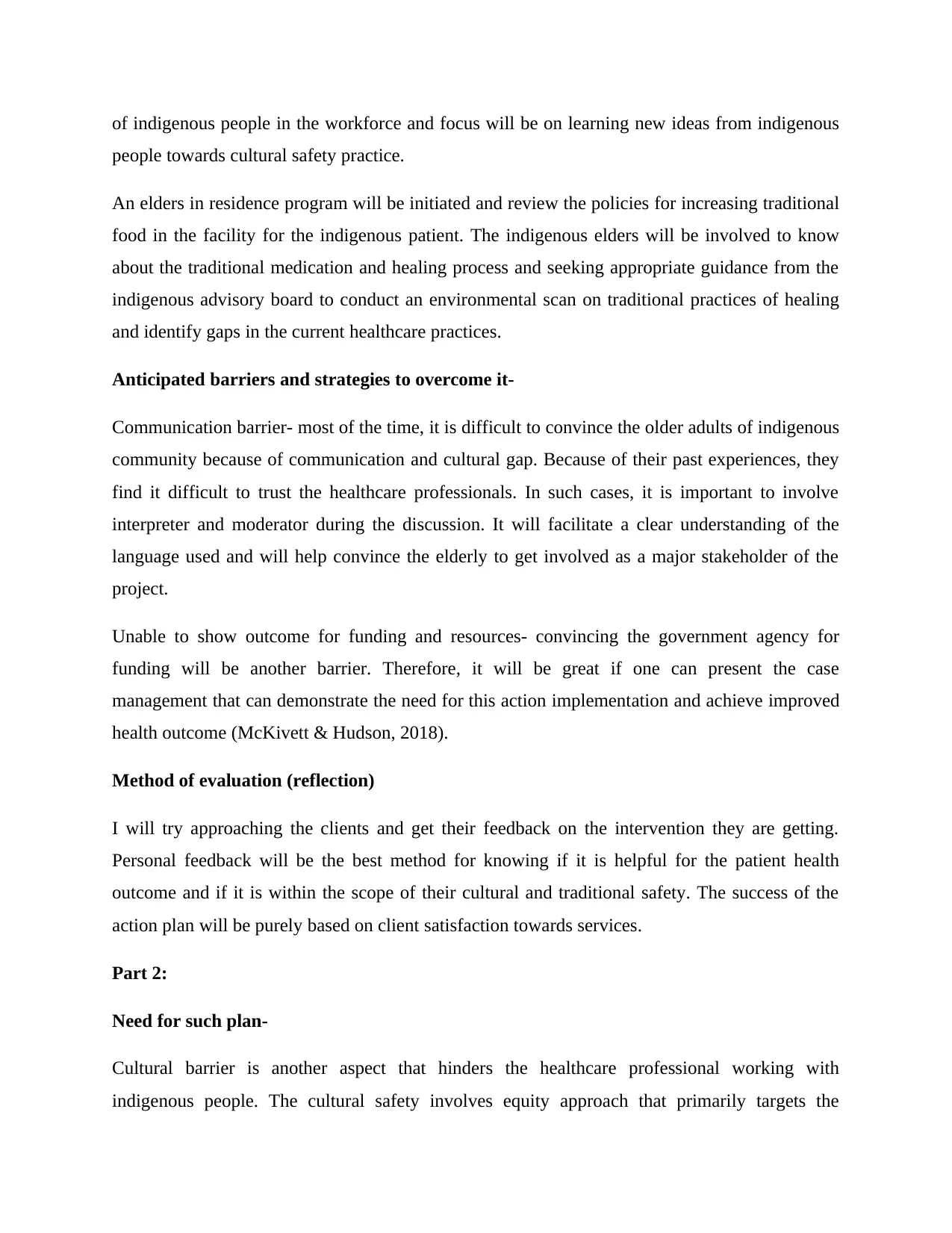
of indigenous people in the workforce and focus will be on learning new ideas from indigenous
people towards cultural safety practice.
An elders in residence program will be initiated and review the policies for increasing traditional
food in the facility for the indigenous patient. The indigenous elders will be involved to know
about the traditional medication and healing process and seeking appropriate guidance from the
indigenous advisory board to conduct an environmental scan on traditional practices of healing
and identify gaps in the current healthcare practices.
Anticipated barriers and strategies to overcome it-
Communication barrier- most of the time, it is difficult to convince the older adults of indigenous
community because of communication and cultural gap. Because of their past experiences, they
find it difficult to trust the healthcare professionals. In such cases, it is important to involve
interpreter and moderator during the discussion. It will facilitate a clear understanding of the
language used and will help convince the elderly to get involved as a major stakeholder of the
project.
Unable to show outcome for funding and resources- convincing the government agency for
funding will be another barrier. Therefore, it will be great if one can present the case
management that can demonstrate the need for this action implementation and achieve improved
health outcome (McKivett & Hudson, 2018).
Method of evaluation (reflection)
I will try approaching the clients and get their feedback on the intervention they are getting.
Personal feedback will be the best method for knowing if it is helpful for the patient health
outcome and if it is within the scope of their cultural and traditional safety. The success of the
action plan will be purely based on client satisfaction towards services.
Part 2:
Need for such plan-
Cultural barrier is another aspect that hinders the healthcare professional working with
indigenous people. The cultural safety involves equity approach that primarily targets the
people towards cultural safety practice.
An elders in residence program will be initiated and review the policies for increasing traditional
food in the facility for the indigenous patient. The indigenous elders will be involved to know
about the traditional medication and healing process and seeking appropriate guidance from the
indigenous advisory board to conduct an environmental scan on traditional practices of healing
and identify gaps in the current healthcare practices.
Anticipated barriers and strategies to overcome it-
Communication barrier- most of the time, it is difficult to convince the older adults of indigenous
community because of communication and cultural gap. Because of their past experiences, they
find it difficult to trust the healthcare professionals. In such cases, it is important to involve
interpreter and moderator during the discussion. It will facilitate a clear understanding of the
language used and will help convince the elderly to get involved as a major stakeholder of the
project.
Unable to show outcome for funding and resources- convincing the government agency for
funding will be another barrier. Therefore, it will be great if one can present the case
management that can demonstrate the need for this action implementation and achieve improved
health outcome (McKivett & Hudson, 2018).
Method of evaluation (reflection)
I will try approaching the clients and get their feedback on the intervention they are getting.
Personal feedback will be the best method for knowing if it is helpful for the patient health
outcome and if it is within the scope of their cultural and traditional safety. The success of the
action plan will be purely based on client satisfaction towards services.
Part 2:
Need for such plan-
Cultural barrier is another aspect that hinders the healthcare professional working with
indigenous people. The cultural safety involves equity approach that primarily targets the
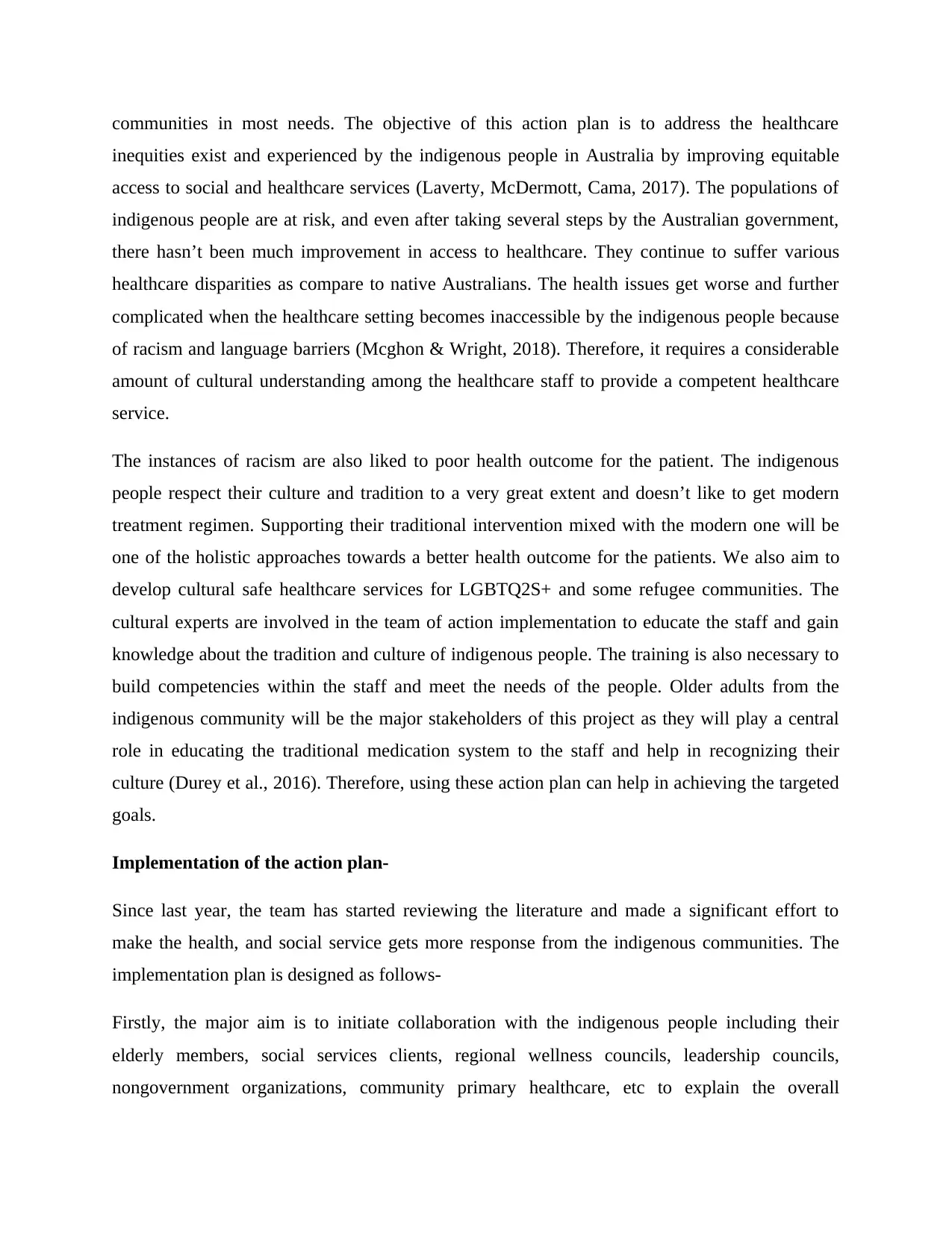
communities in most needs. The objective of this action plan is to address the healthcare
inequities exist and experienced by the indigenous people in Australia by improving equitable
access to social and healthcare services (Laverty, McDermott, Cama, 2017). The populations of
indigenous people are at risk, and even after taking several steps by the Australian government,
there hasn’t been much improvement in access to healthcare. They continue to suffer various
healthcare disparities as compare to native Australians. The health issues get worse and further
complicated when the healthcare setting becomes inaccessible by the indigenous people because
of racism and language barriers (Mcghon & Wright, 2018). Therefore, it requires a considerable
amount of cultural understanding among the healthcare staff to provide a competent healthcare
service.
The instances of racism are also liked to poor health outcome for the patient. The indigenous
people respect their culture and tradition to a very great extent and doesn’t like to get modern
treatment regimen. Supporting their traditional intervention mixed with the modern one will be
one of the holistic approaches towards a better health outcome for the patients. We also aim to
develop cultural safe healthcare services for LGBTQ2S+ and some refugee communities. The
cultural experts are involved in the team of action implementation to educate the staff and gain
knowledge about the tradition and culture of indigenous people. The training is also necessary to
build competencies within the staff and meet the needs of the people. Older adults from the
indigenous community will be the major stakeholders of this project as they will play a central
role in educating the traditional medication system to the staff and help in recognizing their
culture (Durey et al., 2016). Therefore, using these action plan can help in achieving the targeted
goals.
Implementation of the action plan-
Since last year, the team has started reviewing the literature and made a significant effort to
make the health, and social service gets more response from the indigenous communities. The
implementation plan is designed as follows-
Firstly, the major aim is to initiate collaboration with the indigenous people including their
elderly members, social services clients, regional wellness councils, leadership councils,
nongovernment organizations, community primary healthcare, etc to explain the overall
inequities exist and experienced by the indigenous people in Australia by improving equitable
access to social and healthcare services (Laverty, McDermott, Cama, 2017). The populations of
indigenous people are at risk, and even after taking several steps by the Australian government,
there hasn’t been much improvement in access to healthcare. They continue to suffer various
healthcare disparities as compare to native Australians. The health issues get worse and further
complicated when the healthcare setting becomes inaccessible by the indigenous people because
of racism and language barriers (Mcghon & Wright, 2018). Therefore, it requires a considerable
amount of cultural understanding among the healthcare staff to provide a competent healthcare
service.
The instances of racism are also liked to poor health outcome for the patient. The indigenous
people respect their culture and tradition to a very great extent and doesn’t like to get modern
treatment regimen. Supporting their traditional intervention mixed with the modern one will be
one of the holistic approaches towards a better health outcome for the patients. We also aim to
develop cultural safe healthcare services for LGBTQ2S+ and some refugee communities. The
cultural experts are involved in the team of action implementation to educate the staff and gain
knowledge about the tradition and culture of indigenous people. The training is also necessary to
build competencies within the staff and meet the needs of the people. Older adults from the
indigenous community will be the major stakeholders of this project as they will play a central
role in educating the traditional medication system to the staff and help in recognizing their
culture (Durey et al., 2016). Therefore, using these action plan can help in achieving the targeted
goals.
Implementation of the action plan-
Since last year, the team has started reviewing the literature and made a significant effort to
make the health, and social service gets more response from the indigenous communities. The
implementation plan is designed as follows-
Firstly, the major aim is to initiate collaboration with the indigenous people including their
elderly members, social services clients, regional wellness councils, leadership councils,
nongovernment organizations, community primary healthcare, etc to explain the overall
⊘ This is a preview!⊘
Do you want full access?
Subscribe today to unlock all pages.

Trusted by 1+ million students worldwide
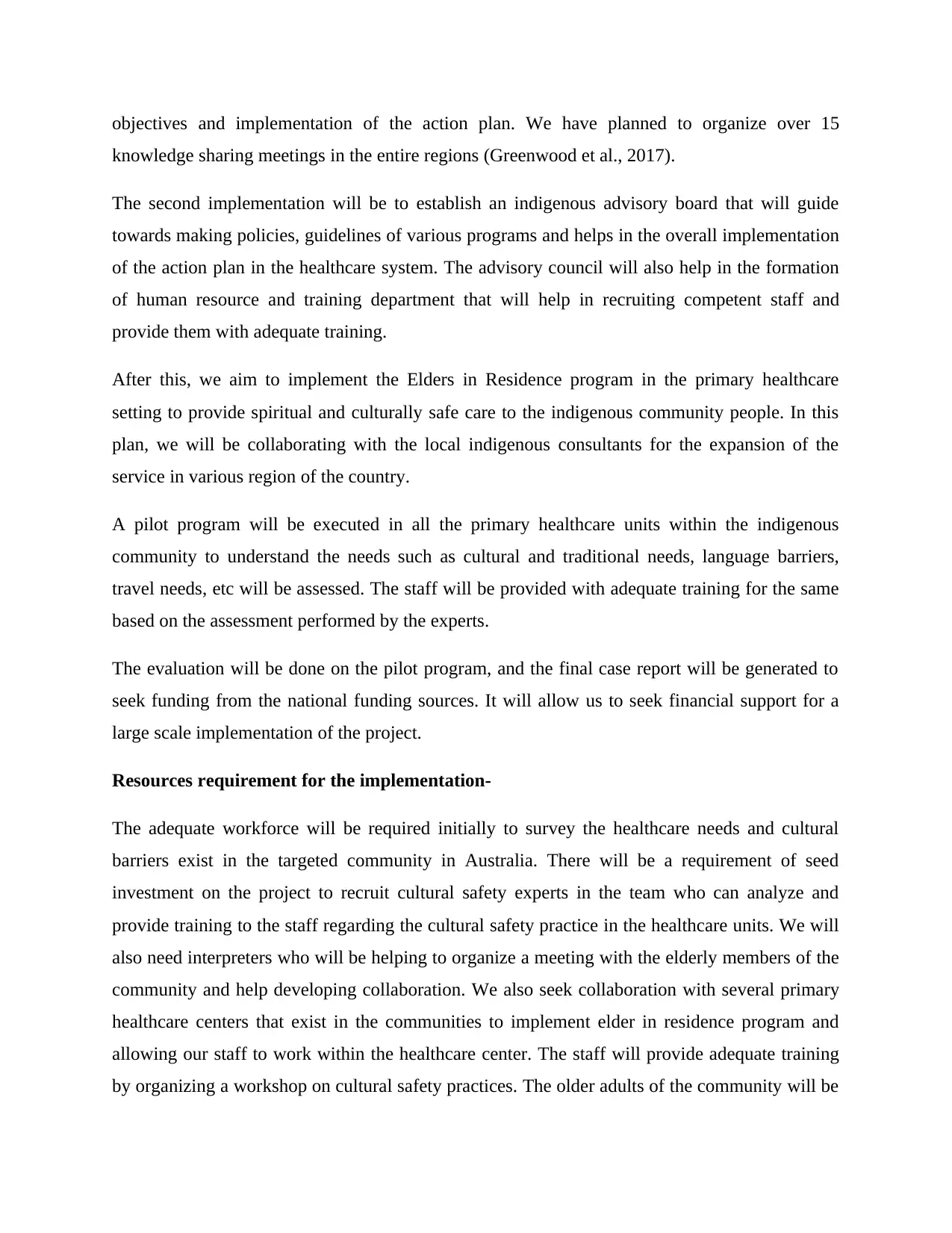
objectives and implementation of the action plan. We have planned to organize over 15
knowledge sharing meetings in the entire regions (Greenwood et al., 2017).
The second implementation will be to establish an indigenous advisory board that will guide
towards making policies, guidelines of various programs and helps in the overall implementation
of the action plan in the healthcare system. The advisory council will also help in the formation
of human resource and training department that will help in recruiting competent staff and
provide them with adequate training.
After this, we aim to implement the Elders in Residence program in the primary healthcare
setting to provide spiritual and culturally safe care to the indigenous community people. In this
plan, we will be collaborating with the local indigenous consultants for the expansion of the
service in various region of the country.
A pilot program will be executed in all the primary healthcare units within the indigenous
community to understand the needs such as cultural and traditional needs, language barriers,
travel needs, etc will be assessed. The staff will be provided with adequate training for the same
based on the assessment performed by the experts.
The evaluation will be done on the pilot program, and the final case report will be generated to
seek funding from the national funding sources. It will allow us to seek financial support for a
large scale implementation of the project.
Resources requirement for the implementation-
The adequate workforce will be required initially to survey the healthcare needs and cultural
barriers exist in the targeted community in Australia. There will be a requirement of seed
investment on the project to recruit cultural safety experts in the team who can analyze and
provide training to the staff regarding the cultural safety practice in the healthcare units. We will
also need interpreters who will be helping to organize a meeting with the elderly members of the
community and help developing collaboration. We also seek collaboration with several primary
healthcare centers that exist in the communities to implement elder in residence program and
allowing our staff to work within the healthcare center. The staff will provide adequate training
by organizing a workshop on cultural safety practices. The older adults of the community will be
knowledge sharing meetings in the entire regions (Greenwood et al., 2017).
The second implementation will be to establish an indigenous advisory board that will guide
towards making policies, guidelines of various programs and helps in the overall implementation
of the action plan in the healthcare system. The advisory council will also help in the formation
of human resource and training department that will help in recruiting competent staff and
provide them with adequate training.
After this, we aim to implement the Elders in Residence program in the primary healthcare
setting to provide spiritual and culturally safe care to the indigenous community people. In this
plan, we will be collaborating with the local indigenous consultants for the expansion of the
service in various region of the country.
A pilot program will be executed in all the primary healthcare units within the indigenous
community to understand the needs such as cultural and traditional needs, language barriers,
travel needs, etc will be assessed. The staff will be provided with adequate training for the same
based on the assessment performed by the experts.
The evaluation will be done on the pilot program, and the final case report will be generated to
seek funding from the national funding sources. It will allow us to seek financial support for a
large scale implementation of the project.
Resources requirement for the implementation-
The adequate workforce will be required initially to survey the healthcare needs and cultural
barriers exist in the targeted community in Australia. There will be a requirement of seed
investment on the project to recruit cultural safety experts in the team who can analyze and
provide training to the staff regarding the cultural safety practice in the healthcare units. We will
also need interpreters who will be helping to organize a meeting with the elderly members of the
community and help developing collaboration. We also seek collaboration with several primary
healthcare centers that exist in the communities to implement elder in residence program and
allowing our staff to work within the healthcare center. The staff will provide adequate training
by organizing a workshop on cultural safety practices. The older adults of the community will be
Paraphrase This Document
Need a fresh take? Get an instant paraphrase of this document with our AI Paraphraser
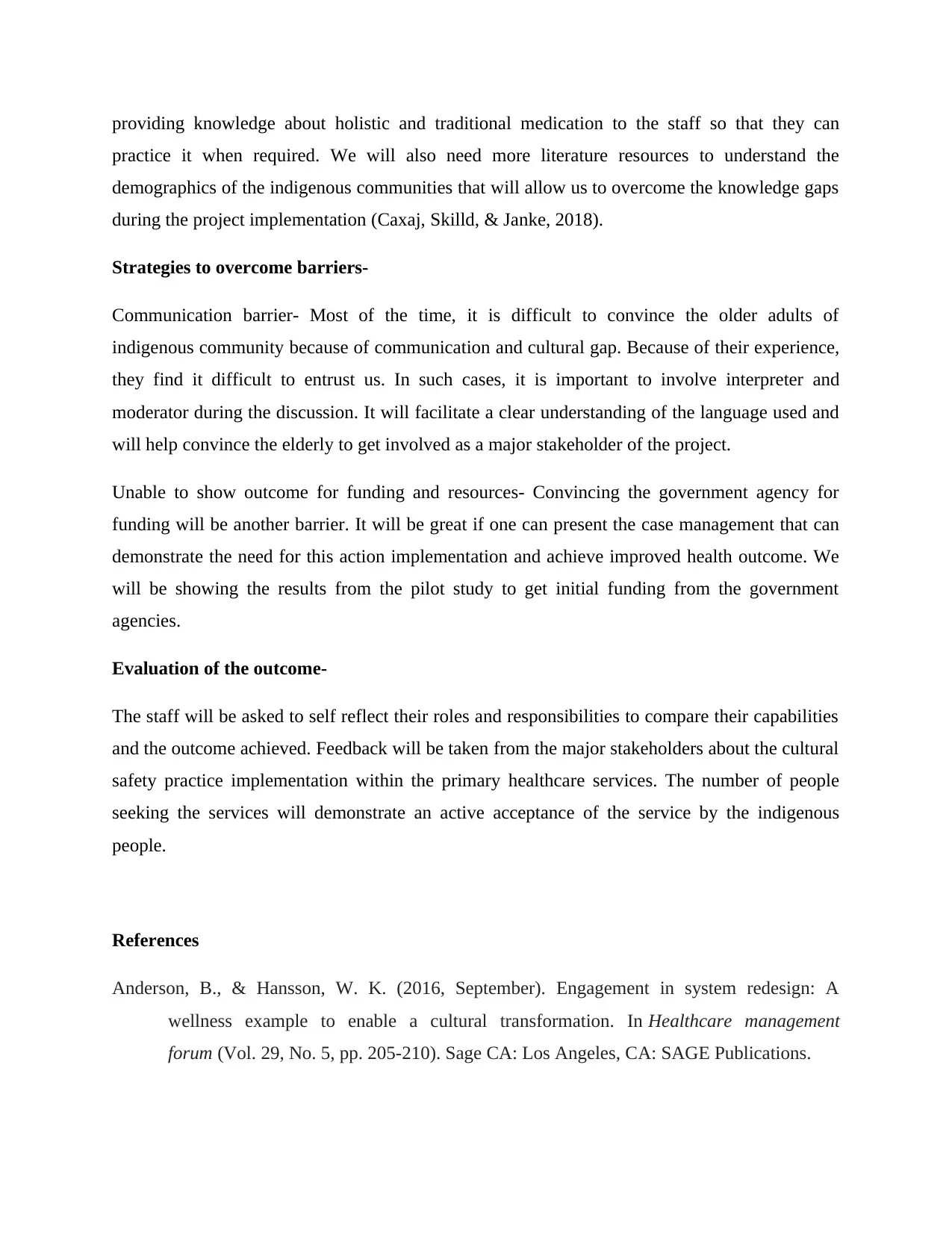
providing knowledge about holistic and traditional medication to the staff so that they can
practice it when required. We will also need more literature resources to understand the
demographics of the indigenous communities that will allow us to overcome the knowledge gaps
during the project implementation (Caxaj, Skilld, & Janke, 2018).
Strategies to overcome barriers-
Communication barrier- Most of the time, it is difficult to convince the older adults of
indigenous community because of communication and cultural gap. Because of their experience,
they find it difficult to entrust us. In such cases, it is important to involve interpreter and
moderator during the discussion. It will facilitate a clear understanding of the language used and
will help convince the elderly to get involved as a major stakeholder of the project.
Unable to show outcome for funding and resources- Convincing the government agency for
funding will be another barrier. It will be great if one can present the case management that can
demonstrate the need for this action implementation and achieve improved health outcome. We
will be showing the results from the pilot study to get initial funding from the government
agencies.
Evaluation of the outcome-
The staff will be asked to self reflect their roles and responsibilities to compare their capabilities
and the outcome achieved. Feedback will be taken from the major stakeholders about the cultural
safety practice implementation within the primary healthcare services. The number of people
seeking the services will demonstrate an active acceptance of the service by the indigenous
people.
References
Anderson, B., & Hansson, W. K. (2016, September). Engagement in system redesign: A
wellness example to enable a cultural transformation. In Healthcare management
forum (Vol. 29, No. 5, pp. 205-210). Sage CA: Los Angeles, CA: SAGE Publications.
practice it when required. We will also need more literature resources to understand the
demographics of the indigenous communities that will allow us to overcome the knowledge gaps
during the project implementation (Caxaj, Skilld, & Janke, 2018).
Strategies to overcome barriers-
Communication barrier- Most of the time, it is difficult to convince the older adults of
indigenous community because of communication and cultural gap. Because of their experience,
they find it difficult to entrust us. In such cases, it is important to involve interpreter and
moderator during the discussion. It will facilitate a clear understanding of the language used and
will help convince the elderly to get involved as a major stakeholder of the project.
Unable to show outcome for funding and resources- Convincing the government agency for
funding will be another barrier. It will be great if one can present the case management that can
demonstrate the need for this action implementation and achieve improved health outcome. We
will be showing the results from the pilot study to get initial funding from the government
agencies.
Evaluation of the outcome-
The staff will be asked to self reflect their roles and responsibilities to compare their capabilities
and the outcome achieved. Feedback will be taken from the major stakeholders about the cultural
safety practice implementation within the primary healthcare services. The number of people
seeking the services will demonstrate an active acceptance of the service by the indigenous
people.
References
Anderson, B., & Hansson, W. K. (2016, September). Engagement in system redesign: A
wellness example to enable a cultural transformation. In Healthcare management
forum (Vol. 29, No. 5, pp. 205-210). Sage CA: Los Angeles, CA: SAGE Publications.
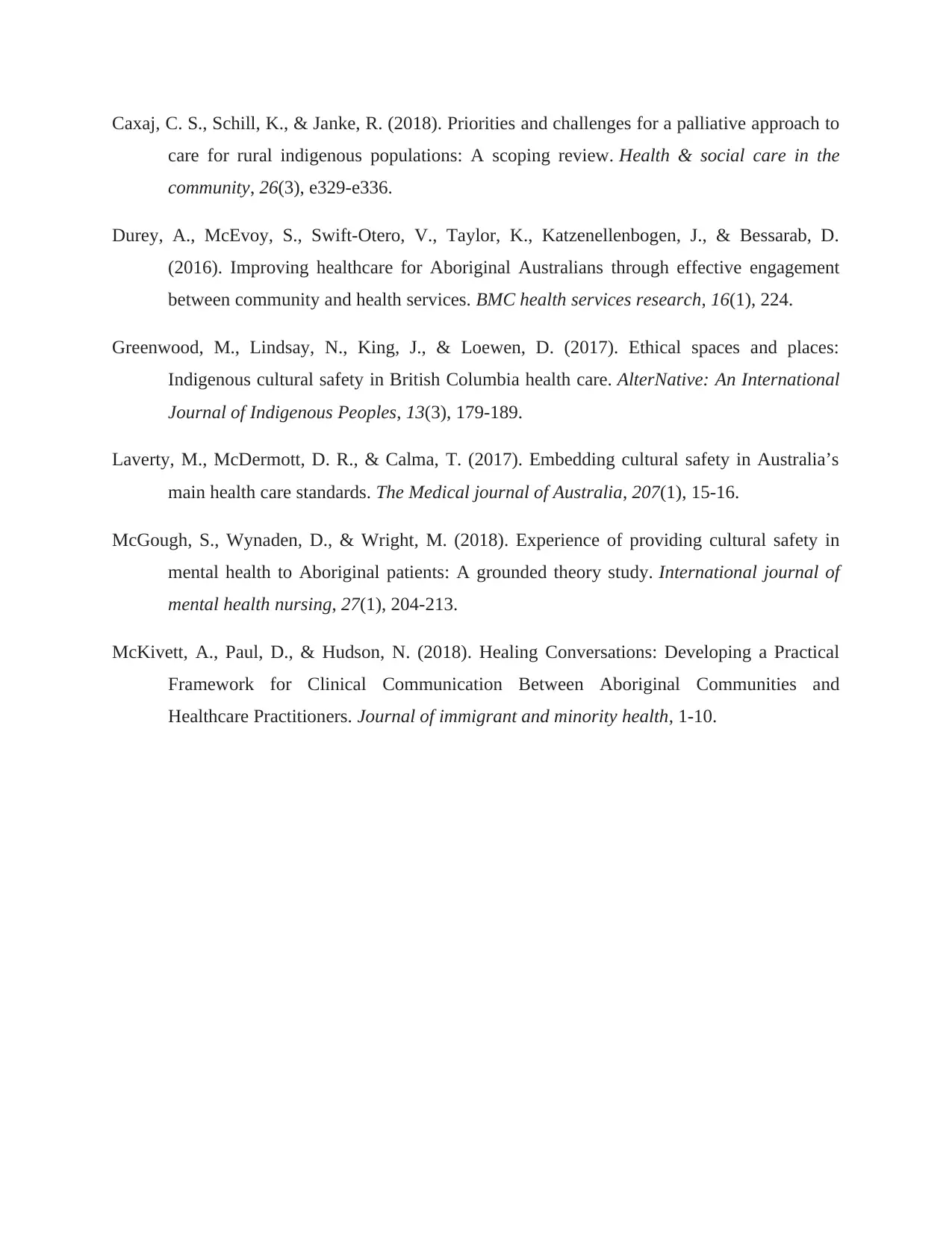
Caxaj, C. S., Schill, K., & Janke, R. (2018). Priorities and challenges for a palliative approach to
care for rural indigenous populations: A scoping review. Health & social care in the
community, 26(3), e329-e336.
Durey, A., McEvoy, S., Swift-Otero, V., Taylor, K., Katzenellenbogen, J., & Bessarab, D.
(2016). Improving healthcare for Aboriginal Australians through effective engagement
between community and health services. BMC health services research, 16(1), 224.
Greenwood, M., Lindsay, N., King, J., & Loewen, D. (2017). Ethical spaces and places:
Indigenous cultural safety in British Columbia health care. AlterNative: An International
Journal of Indigenous Peoples, 13(3), 179-189.
Laverty, M., McDermott, D. R., & Calma, T. (2017). Embedding cultural safety in Australia’s
main health care standards. The Medical journal of Australia, 207(1), 15-16.
McGough, S., Wynaden, D., & Wright, M. (2018). Experience of providing cultural safety in
mental health to Aboriginal patients: A grounded theory study. International journal of
mental health nursing, 27(1), 204-213.
McKivett, A., Paul, D., & Hudson, N. (2018). Healing Conversations: Developing a Practical
Framework for Clinical Communication Between Aboriginal Communities and
Healthcare Practitioners. Journal of immigrant and minority health, 1-10.
care for rural indigenous populations: A scoping review. Health & social care in the
community, 26(3), e329-e336.
Durey, A., McEvoy, S., Swift-Otero, V., Taylor, K., Katzenellenbogen, J., & Bessarab, D.
(2016). Improving healthcare for Aboriginal Australians through effective engagement
between community and health services. BMC health services research, 16(1), 224.
Greenwood, M., Lindsay, N., King, J., & Loewen, D. (2017). Ethical spaces and places:
Indigenous cultural safety in British Columbia health care. AlterNative: An International
Journal of Indigenous Peoples, 13(3), 179-189.
Laverty, M., McDermott, D. R., & Calma, T. (2017). Embedding cultural safety in Australia’s
main health care standards. The Medical journal of Australia, 207(1), 15-16.
McGough, S., Wynaden, D., & Wright, M. (2018). Experience of providing cultural safety in
mental health to Aboriginal patients: A grounded theory study. International journal of
mental health nursing, 27(1), 204-213.
McKivett, A., Paul, D., & Hudson, N. (2018). Healing Conversations: Developing a Practical
Framework for Clinical Communication Between Aboriginal Communities and
Healthcare Practitioners. Journal of immigrant and minority health, 1-10.
⊘ This is a preview!⊘
Do you want full access?
Subscribe today to unlock all pages.

Trusted by 1+ million students worldwide
1 out of 6
Related Documents
Your All-in-One AI-Powered Toolkit for Academic Success.
+13062052269
info@desklib.com
Available 24*7 on WhatsApp / Email
![[object Object]](/_next/static/media/star-bottom.7253800d.svg)
Unlock your academic potential
Copyright © 2020–2025 A2Z Services. All Rights Reserved. Developed and managed by ZUCOL.





